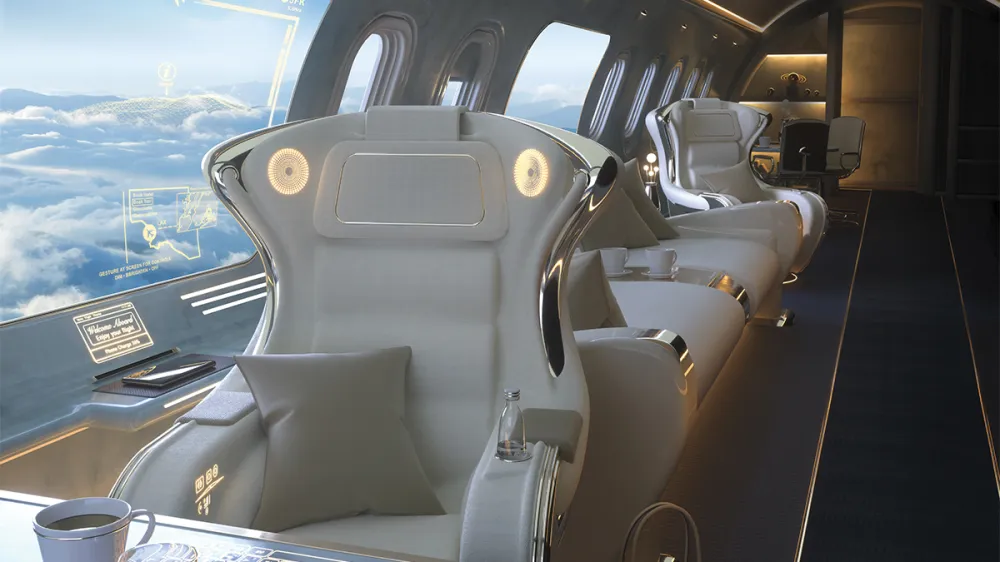Extreme leisure or full-throttle engagement? The private-jet cabin of the future will offer both.
Within a decade, private jet cabins could make even today’s cutting-edge interiors seem ancient by comparison. From digital skylights and smart seats to eye-tracking functionality and immersive soundscapes, the array of innovative amenities could transform even the longest flights into time well spent. Here, six areas in which technology will take the onboard experience to new heights.
Screen Time
Within three to five years, some private jets may have select windows replaced with curved, high-definition 4K OLED displays connected to live video feeds from the aircraft’s exterior. Imagine a cabin ceiling that morphs into a conservatory with a spectacular view of the moon, or full-height windows that present the landscape below with incredible fidelity. Information overlays are easy additions, but consider that these built-in visual portals could also double as insane gaming screens.
Seat Change
E-textiles will transform the next generation of jet seats into intuitive in-flight spa recliners. Sensors within the fabric will note your size, weight, pressure distribution, and body temperature, then rely on their A.I.-driven processors to, say, heat the seat before you realize you’re chilly or massage that kink in your back without being asked. Powering themselves by converting body heat into electricity, the chairs might also know to widen and recline when you nod off.
Seeing the Light
Chronobiological lighting to mitigate jet lag will comprise organic light-emitting diode (OLED) panels, capable of creating 16.3 million different light combinations, to reset a passenger’s internal clock as they traverse time zones. Eventually, such panels will migrate from light fixtures to smart fabric on the ceiling, resulting in more diffuse illumination that allows for near-infinite options across the color spectrum.
And there are many other applications. For example, OLED displays, as wide as a piece of paper, can be used to digitally transform the entire wall of the cabin’s color, texture or scene. It is called projection mapping, and it will make changing the wall color from hot pink to a textured crocodile leather as easy as changing your computer screen saver. As Ingo Wuggetzer, vice president of cabin marketing for Airbus, explains, light literally creates spaces, giving cabin designers a highly versatile and easily customizable digital canvas.
Higher Management
The ability to access basic audio or video from your smartphone is here, but imagine faster, streamlined connectivity that lets you manage video conferencing, heating, mood lighting, window shades, service requests, even a sterilizer—from a single app. According to Airbus’s Wuggetzer, next-gen digital architecture will turn personal spaces into individual “ecosystems” controlled by each passenger. Tim O’Hara, director of completions research and development at Gulfstream, notes that eye-tracking technology could allow you to interact with the app via virtual screen, meaning you don’t even have to lift a finger.
Breaking the Sound Barrier
Rosen Aviation has developed a new onboard audio system with Laurence Dickie, designer of the famed Bowers & Wilkins Nautilus loudspeaker. According to Rosen’s Lee Clark, the goal is to go from today’s audio equivalent of “a 1970s eight-track” to what he refers to as “Elvis, six feet away, singing to you”—a soundscape that only you will hear, delivered by headrest speakers and haptic drivers in the seat. Meanwhile, Bongiovi Aviation intends to employ transducers embedded in the jet’s interior side panels, eliminating the need for traditional speakers altogether. The advantages are numerous, and it allows airframers to reduce cabin weight and fully utilize space while eliminating traditional speakers from the design.
Bringing movie-theater audio quality to aviation is already available. Dolby Atmos puts you inside the movie or song as it is playing. In collaboration with Dolby, SkyCinema Aviation was the first to create an Atmos-enabled processor built for business jets to compensate for cabin altitude and jet noise. The result? You will clearly hear the car approaching from a half mile away in that famous scene of the 1959 Hitchcock classic North by Northwest, just as the director intended.
Hands Free
With full showers, skylights, and large vanities gracing the lavatories of the most luxe business jets today, what could be next? The smart lavatory is evolving into a nearly completely hands-free space by incorporating sensors to activate everything from faucets to showers. Using an AI algorithm, Diehl Aviation has taken it a step farther to add more functionality with voice-controlled commands for opening and closing the door, turning on lights, and activating water. Hologram light switches will eventually keep the lavatory completely hands free, while smart mirrors can multitask by providing an interactive display of digital content.








